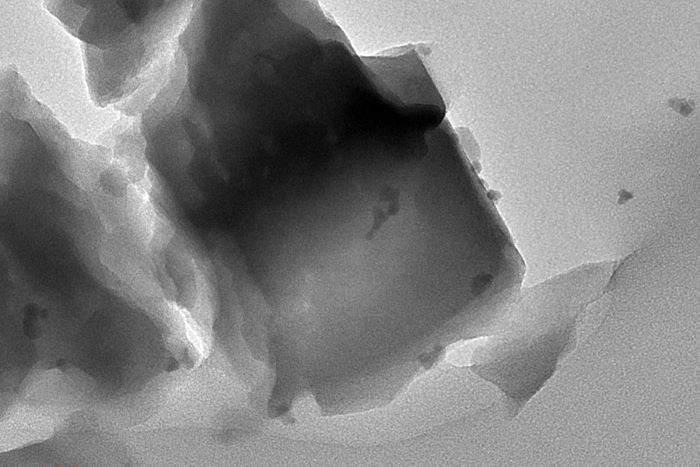Reviewed by Lexie CornerDec 5 2024
Chemical engineers at the Massachusetts Institute of Technology (MIT) have developed a catalyst that can convert methane into useful polymers. This research was published in Nature Catalysis, offering a potential approach to reducing greenhouse gas emissions.
 MIT chemical engineers designed a two-part catalyst that can convert methane gas to useful products. The catalyst consists of iron-modified aluminum silicate plus an enzyme called alcohol oxidase (enzyme not pictured). Image Credit: Courtesy of the researchers
MIT chemical engineers designed a two-part catalyst that can convert methane gas to useful products. The catalyst consists of iron-modified aluminum silicate plus an enzyme called alcohol oxidase (enzyme not pictured). Image Credit: Courtesy of the researchers
Although less abundant than carbon dioxide, methane absorbs more heat in the atmosphere because of its molecular structure, making it a significant contributor to global warming.
What to do with methane has been a longstanding problem. It is a source of carbon, and we want to keep it out of the atmosphere but also turn it into something useful.
Michael Strano, Study Senior Author and Carbon P. Dubbs Professor, Chemical Engineering, Massachusetts Institute of Technology
The new catalyst functions at ambient temperature and atmospheric pressure, making it more practical and cost-effective for use in methane-producing facilities such as power plants and livestock farms.
The study was led by Daniel Lundberg, Ph.D.'24, and Jimin Kim, an MIT postdoc, with contributions from former postdoc Yu-Ming Tu and postdoc Cody Ritt.
Capturing Methane
Methane is produced by bacteria known as methanogens, commonly found in landfills, swamps, and other areas with decaying biomass. While methane is largely produced by agriculture, it is also a byproduct of natural gas transportation, storage, and combustion, contributing to about 15 % of global temperature increases.
At the molecular level, methane consists of a single carbon atom bonded to four hydrogen atoms. In theory, this molecule could be used as a building block for producing useful products like polymers. However, converting methane into other compounds has been challenging, as reactions typically require high temperatures and pressures.
The MIT team created a hybrid catalyst consisting of a naturally occurring enzyme and a zeolite to accomplish methane conversion without the need for energy input. Previous studies have shown that zeolites, which are cheap, abundant minerals that resemble clay, can be utilized to accelerate the conversion of methane to carbon dioxide.
A zeolite known as iron-modified aluminum silicate and an enzyme known as alcohol oxidase was employed in this study. This enzyme is used by plants, fungi, and bacteria to oxidize alcohols.
This hybrid catalyst helps zeolite convert methane to methanol, which in turn is converted to formaldehyde by an enzyme. That reaction produces hydrogen peroxide, which is supplied back into the zeolite to supply oxygen for the methane-to-methanol conversion process.
This sequence of reactions does not require high pressure, as they occur at normal temperatures. The water in which the catalyst particles are suspended can absorb methane from the surrounding air. The researchers believe that this process could be applied to surfaces in future applications, such as in methane capture or conversion technologies.
Other systems operate at high temperature and high pressure, and they use hydrogen peroxide, which is an expensive chemical, to drive the methane oxidation. But our enzyme produces hydrogen peroxide from oxygen, so I think our system could be very cost-effective and scalable.
Jimin Kim, Postdoctoral Researcher, Massachusetts Institute of Technology
According to Damien Debecker, a professor at the Institute of Condensed Matter and Nanosciences at the University of Louvain in Belgium, developing a system that combines both enzymes and synthetic catalysts is a “smart strategy.”
Combining these two families of catalysts is challenging, as they tend to operate in rather distinct operation conditions. By unlocking this constraint and mastering the art of chemo-enzymatic cooperation, hybrid catalysis becomes key-enabling: It opens new perspectives to run complex reaction systems in an intensified way.
Damien Debecker, Professor, Institute of Condensed Matter, University of Louvain
Building Polymers
The researchers demonstrated that by adding urea, a nitrogen-containing molecule found in urine, to formaldehyde, they were able to create polymers. Urea-formaldehyde, a resin-like polymer, is commonly used in textiles, particle boards, and various other products.
They envision applying this catalyst in natural gas pipelines, where it could be used to produce polymers that could act as sealants for cracks, a common cause of methane leaks. The researchers suggest that this catalyst could also be applied as a coating on surfaces exposed to methane gas, allowing for the collection of polymers that could be repurposed for manufacturing.
In addition, Strano’s lab is working on catalysts that may extract carbon dioxide from the environment and combine it with nitrate to produce urea, which could then be used in combination with formaldehyde generated by the zeolite-enzyme catalyst to produce urea-formaldehyde.
The study received support from the US Department of Energy.
Journal Reference:
Lundberg, D. J. et. al. (2024) Concerted methane fixation at ambient temperature and pressure mediated by an alcohol oxidase and Fe-ZSM-5 catalytic couple. Nature Catalysis. doi.org/10.1038/s41929-024-01251-z